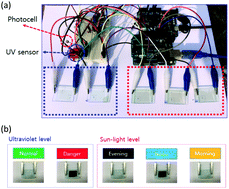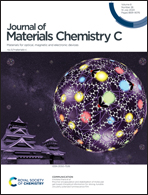Electrochromic devices based on ultraviolet-cured poly(methyl methacrylate) gel electrolytes and their utilisation in smart window applications†
Abstract
Electrochromic devices (ECDs) have been widely investigated for application in next-generation displays and smart windows thanks to their highly efficient optical transmittance modulation properties. However, several challenges such as chemical and environmental instabilities and leakage of electrolytes limit their practical applications. In this paper, we report a simple and efficient approach for synthesising ultraviolet (UV)-cured poly(methyl methacrylate) (PMMA) gels that can be used as safe electrolytes. The ECDs fabricated with the 10 min UV-cured PMMA gel electrolyte deliver remarkable device performances with a wide optical transmittance transition (ΔT) of 51.3% at a wavelength of 550 nm under −1.2–0 V bias range and fast switching times (Δt) of 1.5 s and 2.0 s for bleaching and colouration, respectively. In addition, excellent operational stability of 98.9% after 11 500 cycles and environmental stability at a wide temperature range of −20 to +70 °C are exhibited. Moreover, a smart electrochromic window system, including an ECD connected with an Arduino circuit, is developed. These smart windows can change colour by simultaneously monitoring the illumination and UV intensities of sunlight.



 Please wait while we load your content...
Please wait while we load your content...